
Brown Snake
Latin name: Storeria dekayi
Size: 5 to 15 inches
Venomous: No
This snake, known as the brown snake, northern brown snake, or DeKay’s snake, has more predators than it does prey items, feeding mostly on earthworms, slugs, snails, and other beetles and bugs it finds as it slithers around underground. Above ground, it falls victim to predators such as humans, domestic cats and dogs, hawks and eagles, other snakes, large toads and frogs, weasels, and many others.
The brown snake can be just as many shades of gray as it is brown, often with a darker stripe that runs along the body, decorated on each side by tiny, uneven, darker spots. They are well-hidden underneath rock piles, or fallen logs when they do finally venture above ground.
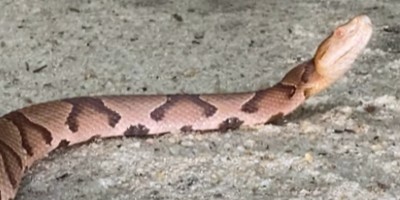 Northern Copperhead
Northern Copperhead
Latin name: Agkistrodon contortrix mokasen
Size: 25 to 40 inches
Venomous: Yes
Also known as the northern and/or eastern copperhead, this copperhead snake lives in mixed woods and deciduous forests, often living close to a body of water, such as swamps, marshes, and wet prairies and grasslands. Heavy bodied, and with a diamond-shaped head, this snake is usually a shade of red, orange, or - as the name suggests - copper. Darker bands decorate the body, although these can come in a variety of shapes and styles, with some being compared to an hourglass shape.
Although venomous and quick-to-bite if stood on or startled, this pit viper will freeze to avoid detection, and will display a number of warning signs before finally biting to inject venom.
Red Corn Snake
Latin name: Pantherophis guttatus
Size: Up to 70 inches
Venomous: No
Corn snakes are very common snakes, found across a lot of other southeastern states of the USA. Often a brown-yellow colour, with uneven-edges patches of darker colours across the top of the body, they are a species commonly mixed up with other species; and with the growing pet industry, this snake species has been specifically bred to mimic the colourations or markings of a range of other snake species. Generally, in the wild, the colouration and markings of the snake will be determined by the kind of habitat it lives in.
Mountain Earth Snake
Latin name: Virginia valeriae pulchra
Size: 7 to 10 inches
Venomous: No
The mountain earth snake can sometimes be found in the far west of Maryland, although it is very small and slender, and is known to be very secretive. You would likely need to turn over logs, branches, rocks, boulders, or other types of ground debris to find one, or have a rummage around in loose leaves and other vegetation on the ground itself. Very rarely is it found in the open, and even less so in the state of Maryland, where it is an endangered species.
Smooth Green Snake
Latin name: Opheodrys vernalis
Size: 10 to 20 inches
Venomous: No
Smooth green snakes are non-aggressive snakes in Maryland, and a species that can benefit gardeners and agriculturists by devouring huge quantities of slugs, snails, worms, ants, moths, butterflies, caterpillars, spiders, and other insects that might otherwise cause problems with crops or flowers.
The perfect habitat for this snake species is along lakes, streams, rivers, or close to other, similar bodies of water. The green coloration helps it to camouflage in grass-green areas, making marshes, forests, and other grassy areas suitable. It is active during both the day and night when the temperature is warm, but tends to hibernate when temperatures drop, often in older and abandoned rodent burrows, or even in ant hills.
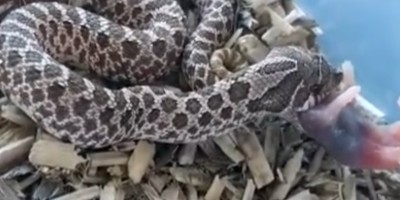 Eastern Hog-Nosed Snake
Eastern Hog-Nosed Snake
Latin name: Heterodon platirhinos
Size: 15 to 42 inches
Venomous: No (Yes, but it doesn't affect humans)
These snakes put on quite a dramatic display when threatened by humans and other predators, which actually makes it easy to identify a species that can often be mistook with others by just colour and markings alone. As well as puffing out its neck and head (earning it the nickname ‘puff adder’), this snake hisses, thrashes a bit, and makes it look as though it is ready to bite at any moment. It rarely does, however. In fact, it behaves just like an opossum does when threatened: it plays dead, tongue hanging out.
Eastern King Snake
Latin name: Lampropeltis getula getula
Size: 36 to 50 inches
Venomous: No
This non-venomous snake is more shy than aggressive and rarely bites. A black snake with shiny scales, there are bands of white, cream or yellow, often compared to the pattern of a chain. Although usually growing up to 50 inches in length, the eastern king snake has had specimens reported up to 80 inches.
It lives in a variety of different habitat types but is commonly reported to inhabit marshes, freshwater bodies (or around), swamps, and most kinds of forests. It usually hides beneath logs, branches, boulders, rocks, or loose leaf litter across the floor.
Northern Mole King Snake
Latin name: Lampropeltis calligaster rhombomaculata
Size: 30 to 40 inches
Venomous: No
A subspecies of the prairie king snake, the northern mole king snake is also commonly referred to as the brown king snake, or sometimes just the mole king snake. Other types of king snake are usually black with lighter stripes, but the mole king snake can be a variety of shades, from brown to gray, and often has brown or rust-red coloured patches — hence the “brown” nickname.
This non-venomous snake is often confused with the venomous copperhead, and the non-venomous milk snake in Maryland, and tends to inhabit similar spaces — forest edges, and areas with dry, but loose substrate.
Coastal Plain Milk Snake
Latin name: Lampropeltis triangulum elapsoides X triangulum
Size: 24 to 36 inches
Venomous: No
Mix together the eastern milk snake and scarlet king snake and you get what experts are calling the coastal plain milk snake — a snake that is new, and research is still ongoing to determine the right genus and species. Known to be one of the best looking snakes in the state of Maryland, the bands of colour are red, white/yellow and black, very much mimicking the venomous coral snake. The bands of black separate the yellow and red, however; that’s how you can tell a venomous species from a non-venomous one.
Sandy soils and mixed woodlands seem to be the best place to spot this hybridised species in the state, and along the coastal plains - just as the name would imply - is the best place to start looking.
 Eastern Milk Snake
Eastern Milk Snake
Latin name: Lampropeltis triangulum
Size: 24 to 52 inches
Venomous: No
This species of snake is one of the most abundant snakes across North America, although it is often confused with other snake species, including the venomous copperhead snake, and sometimes the corn snake or scarlet king snake. Often with a black-and-white almost checkerboard-style underbelly, and a reddish-brown or gray-brown body, decorated with darker, uneven patches, it is sometimes referred to as the red snake, chain snake, checkered adder, chicken snake, and leopard-spotted snake.
Milk snakes eat a wide range of foods, but the primary food source is small mammals, such as mice, voles, and shrews. They are also known to eat lizards, various birds and their eggs, fish, toads and frogs, beetles and other insects.
Queen Snake
Latin name: Regina septemvittata
Size: 13 to 30 inches
Venomous: No
The queen snake is also known by a host of other names, including yellow-bellied snake, seven-striped water snake, brown queen snake, and others. Striped, just as with the garter and other snakes, the feature that makes this snake identifiable is the series of stripes that run along the underside of the reptile. This isn't present in other, similar-looking snakes.
This snake eats primarily crayfish, so when the populations of their prey declines, the snake does, too. Experts have known for a while now that the numbers are declining, although it is not yet considered to be a species of concern. It is thought to be quite rare to see one, though, although they can sometimes be spotted basking in shallow, rocky-bottomed water bodies during summer.
Rainbow Snake
Latin name: Farancia erytrogramma
Size: 36 to 48 inches
Venomous: No
It is in the southern part of the state of Maryland that the rainbow snake lives, but it is unlikely that you will ever spot one in the wild. It is a highly secretive snake, and one that spends virtually all of its time either in, or very close to a body of slow-moving water. This includes blackwater creeks, marshes, coastal plains, and other water bodies that contain eels – one of the primary prey items.
Very few snakes in Maryland (if any) are quite as colourful as this one – and it is every bit as rainbow-coloured as it sounds. With a main body colour of black, the bright red and yellow horizontal bands really stand out, although the yellow colour isn’t present in juveniles.
Eastern Rat Snake
Latin name: Pantherophis alleghaniensis
Size: 36 to 72 inches
Venomous: No
The eastern rat snake is the largest snake you're likely to encounter in Maryland, commonly confused with the northern pine snake or milk snake as juveniles. As the rat snake ages, it loses most of its juvenile pattern and becomes almost entirely black, although faint pale stripes can be observed in some areas. The throat and chin is a creamy-white colour, and the underside has a creamy-white and black checkerboard-style pattern.
The eastern rat snake can live in a variety of habitats, although it seems to enjoy rocky patches, old fields, and farmlands. Following its main source of food (rodents) often takes it into agricultural and residential buildings, such as sheds and barns.
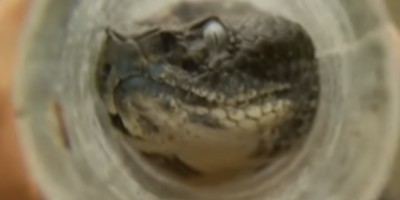 Timber Rattlesnake
Timber Rattlesnake
Latin name: Crotalus horridus
Size: 36 to 60 inches
Venomous: Yes
Timber rattlesnakes are commonly found in upland woods and rocky ridges, and are capable of eating a wide variety of prey items, although many of them tend to have a ‘favourite’ in the area and stick to mostly that. For example, some rattlesnakes will eat exclusively rodents or birds even though they are capable of also consuming lizards, frogs, chipmunks, squirrels, and various other creatures.
Just as with most venomous snakes found in the US, the timber rattlesnake has a narrow neck and a wider head. It is also the third largest venomous snake found in the country, and the second largest venomous species. Fortunately, conflicts are quite rare. The snake is rarely sighted.
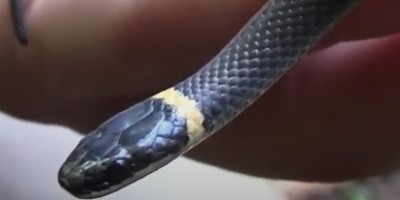 Northern Ring-Necked Snake
Northern Ring-Necked Snake
Latin name: Diadophis punctatus edwardsii
Size: 10 to 15 inches
Venomous: (Yes, but it doesn't affect humans)
As you might suspect from the name, this snake species has a ring of colour around its neck, normally off-white, cream, or yellow in colour, but this marking usually becomes more pronounced as the snake ages. As juveniles, the northern ring-necked snake can look just the same as the brown (or DeKay’s) snake, as well as other species. The only way to tell them apart in this case, is by looking at whether or not the scales are keeled, but this snake will usually have fled before you get close enough to check.
Southern Ring-Necked Snake
Latin name: Diadophis punctatus punctatus
Size: 10 to 15 inches
Venomous: (Yes, but it doesn't affect humans)
This Maryland snake is a secretive one, not usually spotted out in the open, much preferring to spend time either in the water of floodplains or lowlands (being a semi-aquatic species), or slithering around leaf litter in pine or mixed-hardwood forests. The southern ring-necked snake stands out from the other subspecies by a broken collar of colour around the neck region. In other subspecies, the ringed neck area is (or appears to be) unbroken. The ring-necked snake can sometimes be confused with rough and smooth earth snakes, and also DeKay’s (brown) snake.
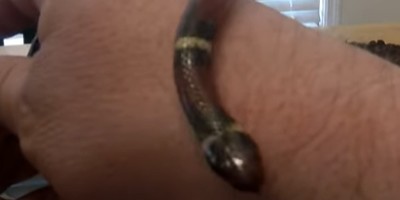 Northern Scarlet Snake
Northern Scarlet Snake
Latin name: Cemophora coccinea copei
Size: 14 to 20 inches
Venomous: No
We don't know an awful lot about scarlet snakes, particularly their breeding activities, because they are such a secretive species. Fossorial in nature, they spend most of their life burrowing in sandy or soft soils, and hiding beneath garden furniture or structures, rock piles, fallen logs, loose leaf litter, and similar.
This nocturnal snake eats mostly snake and other reptile eggs, but it will also eat frogs, other amphibians, small lizards, and also small snakes. It is rarely aggressive, and conflicts between the northern scarlet snake and humans rarely end in bites.
Northern Water Snake
Latin name: Nerodia sipedon
Size: 20 to 55 inches
Venomous: No
Northern water snakes, as the name might lead you to believe, are snakes that prefer to spend their time in water, including marshes, swamps, bogs, ponds, lakes, streams, rivers and lakes. Bodies of water that are wide and open, without lots of vegetation gives the snake plenty of room to bask in the hot sun, but they don't tend to travel too far from the body of water.
The brown, gray, or tan-coloured body of the northern water snake is decorated with square patches that run along the sides, and adult snakes have a tendency to be a lot darker than juveniles, almost one entire shade of black.
Plain-Bellied Water Snake
Latin name: Nerodia erythrogaster
Size: 20 to 55 inches
Venomous: No
The plain-bellied water snake in Maryland was once known as the red-bellied water snake, and it is often mixed up with other water-based snakes. The plain underside is what tells you the species, however, and what gives the snake its name. The rest of its body doesn't usually have markings or patterns and can be a range of tones, from olive green to deep brown, or even black/gray.
The hotter the temperature, the more active this snake is during the day and night — so summer is the season for this species to be out and about. Despite being a mostly aquatic snake, it is not unusual for it to travel far from water, particularly during the summer, to hunt and chase down prey.
Eastern Worm Snake
Latin name: Carphophis amoenus amoenus
Size: 7 to 11 inches
Venomous: No
This snake looks more like a worm than a snake, with a pinkish underbelly, a pinky-brown and smooth-scaled body, and a tiny, pointed head. The pointed head helps the snake to burrow around in soft, moist soil, often in heavily-treed environments, such as woodlands and forests; and it spends almost all of its time underground, occasionally coming up to the surface during the night.
The main food source of this species is the earthworm, but it won't turn down an insect or two, if they are soft-bodied and small enough for the snake to devour whole.